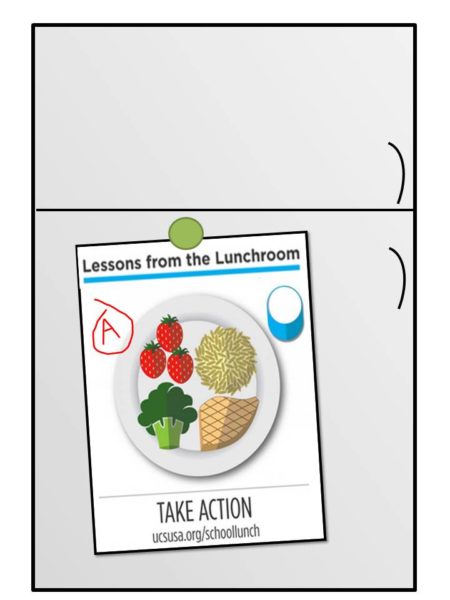School’s out for summer! And while the kids are away, Congress will play—this time with their food. This month, the House Appropriations subcommittee on Agriculture may begin debate on the bill to fund the U.S. Department of Agriculture and related agencies and programs, including child nutrition programs like school meals.
During last year’s appropriations debate, several legislators tried and failed to gut healthier school food standards enacted under the Healthy, Hunger-Free Kids Act (HHFKA) of 2010. HHFKA brought nutrition standards for school meals into accord with evidence-based, federal dietary guidelines. This meant more fruits, vegetables and whole grains and less salt and fat on kids’ plates.
Currently, school nutrition standards require that all grains be “whole grain-rich” (at least 50 percent whole grain), milk is lower-fat (such as fat-free or low-fat), and that all students take ½ cup minimum of fruits and vegetables (fresh, frozen, canned, or in the form of 100% juice) with every federally funded meal. This standard extends to all foods sold and eaten at school, including snacks sold in vending machines. For snack foods, as long as they’re whole grain-rich or the first ingredient is whole grains, fruits, vegetables, or dairy, schools can sell them. As of July 1, 2014, all foods sold in schools participating in the program must meet the updated nutrition standards.
From my public health and policy perspective, this seems pretty reasonable. However, some legislators are skeptical. Last year, Chairman of the House Agriculture Appropriations subcommittee, Robert Aderholt (R-AL) hosted a school meal forum in which he commented, “It is clear to me that it is time for the Administration to h it the pause button on the implementation of school nutrition guidelines and listen to the feedback.”
it the pause button on the implementation of school nutrition guidelines and listen to the feedback.”
So okay, let’s “hit the pause button” and review the evidence.
How are schools handling the implementation of healthier nutrition standards?
Approximately 95% of schools have reported successfully meeting the standards. Back when I was in school (which wasn’t too long ago) – a 95% was considered a solid “A” – a grade that my parents would have proudly displayed on our fridge. However, in response to the schools’ success, Diane Pratt, spokesperson for the School Nutrition Association (SNA) called the achievement “immaterial.” Immaterial? I wonder what SNA’s fridge-worthy grade is…
For those schools that are still facing challenges, the USDA has offered multiple opportunities for schools to receive assistance, including over $30 million in grants this year for preparing fresh foods. Last year, when Rep. Aderholt put the nutrition standards on the chopping block, 19 former School Nutrition Association (SNA) presidents responded with an open letter urging them to “reject calls for waivers, maintain strong standards in all schools and direct USDA to continue working with school leaders and state directors to find ways, including technical assistance, that will ensure all school can meet the HFFKA standards.” They went on to state that, “We must not reverse the progress that was sought by school leaders and is well on its way to success in most schools.”
How are kids reacting to the healthier nutrition standards?
For a moment, forget about the fact that schools are overwhelmingly meeting the standards. How are the kids reacting to these standards? A Rudd Center for Food Policy & Obesity study showed that kids are choosing more fruits, eating more vegetables, and throwing away less food during school lunch.
Additionally, the study found that giving kids more fruit choices increased consumption. Having one additional type of fruit to choose from in the cafeteria was associated with a 9 percent increase in the amount of fruit selected.
In 2014, Harvard published the first study to compare schools before and after they implemented the healthier nutrition standards. The study’s results showed that after the updated standards went into effect, kids selected on average 23% more fruits and consumed 16% more vegetables. The study authors attributed the increases in part to the new requirement that kids had to select ½ cup of fruits and vegetables.
In other words, the best available evidence so far indicates that the standards are working!
What do parents think about the updated school nutrition standards?
In a recent Pew Study, more than 70% of parents say they favor the updated school nutrition standards. Approximately 90% agree that schools should be required to serve a modest half-cup portion of fruits and vegetables. And despite a poorly worded “whole grain rich” definition, 64% agreed that schools should be “required to provide foods made with whole grains with every meal.” Last, but not least, 75% believe that salt should be limited in kids’ meals.
The bottom line: Opting out of nutrition is not the way to go
Despite schools successfully implementing the nutrition standards, strong parental support for healthier school meals, and the potential for good policy to guide an entire generation’s habits in a much healthier direction, sponsors of last year’s failed attempt at dismantling better nutrition standard might try again. To those congressional “picky eaters”—let’s hit the play button:
Children consume at least half of their daily calories in school—and for lower-income kids, this may be their only real meal of the day. With 30 percent of today’s kids overweight or obese, tomorrow’s obesity-related healthcare costs are expected to triple—from $210 billion in 2010 to $550 billion by 2030. Research shows the updated school nutrition standards are working. As Representative Sam Farr (D-CA) said last year during school lunch debates: “Let’s put kids’ health first…This opt out of nutrition is just the wrong way to go.”

